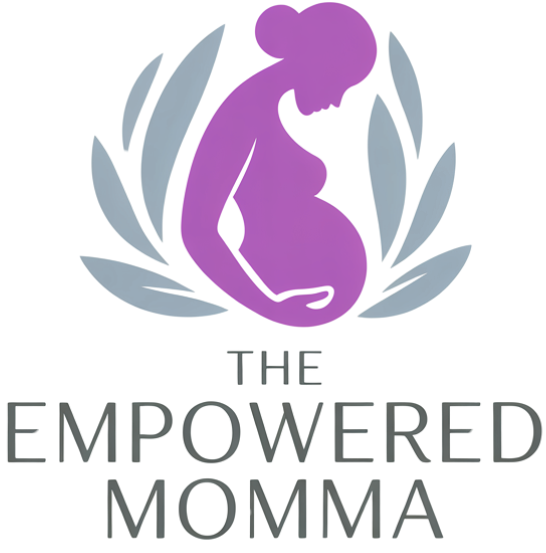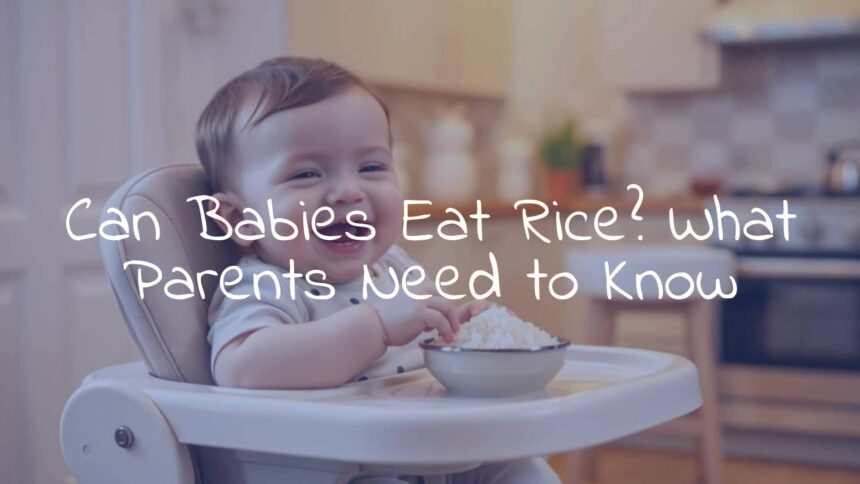Yes, babies can eat rice. Rice is a cereal grain that has been eaten in many parts of the world for a long time and is often given to babies as one of their first solid foods. Its soft texture helps babies learn to chew and get used to new foods. However, parents should pay attention to when and how they introduce rice, and be aware of the possibility of arsenic in rice. Here’s what you need to know to safely include rice in your baby’s diet.
This easy-to-follow guide explains the important points about giving rice to babies, including the right time to start, the safest ways to prepare it, and how to make healthy choices for your child.

When Can Babies Start Eating Rice?
Introducing solid foods is a big step for babies and their families. The right timing can change from one baby to another, but certain guidelines and signs suggest when it’s a good time to start, including when to give rice.
Recommended Age for Starting Rice
Most doctors and health organizations suggest feeding babies only breast milk or formula for the first six months. After that, most babies show signs they are ready to try solids. Rice, often as iron-fortified baby rice cereal, is a common first food, but health experts now suggest feeding babies a range of grains and foods for better nutrition.
Some people recommend giving rice cereal to babies as young as two or three months old, but this is not advised. Waiting until about six months-when your baby shows clear signs of being ready-is safer. Always ask your child’s doctor for advice tailored to your baby.
How to Tell If Your Baby Is Ready for Solids
It’s important to look for these signs, instead of just using the baby’s age:
- Good Head and Neck Control: Baby can hold head up without help, making swallowing safer.
- Sitting Up: Baby can sit with little or no help, showing they are ready to eat solid foods.
- No More Tongue-Thrust Reflex: Babies younger than 4-6 months often push food out with their tongue. This goes away as they get ready for solids.
- Interest in Food: Baby watches you eat, tries to grab your food, or opens mouth when food comes near.
- Clear Signs of Hunger and Being Full: Baby lets you know when hungry or full, by leaning in or turning away.
If your baby shows these signs and the doctor agrees, you can start giving them rice and other new foods.

Is Rice Safe for Babies?
Parents worry about choking, allergies, and if rice is easy to digest. Rice is usually safe for babies, but it helps to know what to watch for.
Choking and Gagging with Rice
Rice is not a common choking hazard, but its stickiness or loose grains can make babies gag. The Centers for Disease Control and Prevention (CDC) lists rice as a possible choking risk for babies under age one, but it is less dangerous than some foods because the grains are small. The key is to prepare rice in a way that’s safe to eat.
Gagging is a protective reflex and common when babies try new foods or textures like rice. It is noisy and involves coughing or watery eyes, but the baby can breathe. Choking is quiet and much more serious. Some rice snacks, such as sticky mochi, are choking risks and should not be served to little kids.
Can Babies Be Allergic to Rice?
Rice allergies are rare, and rice is not one of the main foods that commonly cause allergic reactions. You do not need to wait several days after giving rice before trying new foods. If you see signs of an allergy, speak to your doctor.
One rare reaction is called Food Protein-Induced Enterocolitis Syndrome (FPIES). It causes vomiting and diarrhea hours after eating and means the baby cannot handle certain foods, with rice as a possible cause. If you suspect this, talk to your doctor. Most children outgrow FPIES by age three or four.
Digesting Rice Starch
Some think babies cannot handle starch, but by around six months, their bodies are ready to digest it. Rice gives energy and is safe when included in a baby’s diet from this age, just like bananas and other common foods with starch.
Nutrition: What Does Rice Offer Babies?
Rice is easy to get and prepares in different ways. It gives babies energy and some important nutrients, but its value changes depending on the type of rice used.
Main Nutrients in Rice
Whole grain rice, such as brown rice, gives babies fiber and vitamins. See the table below for key nutrients:
| Nutrient | What It Does |
|---|---|
| Fiber | Aids digestion and helps with fullness, but too much can fill up a baby’s small stomach fast. |
| B vitamins (Thiamin, B6) | Help turn food into energy and support cell and brain function. |
| Magnesium & Phosphorus | Build healthy bones and aid in muscle function. |
| Selenium & Manganese | Protect cells and support immune health. |
| Iron | Helps make healthy blood; babies need extra iron after six months. |
White rice usually has extra vitamins and iron added after processing, but brown rice keeps more natural nutrients. Brown rice is usually more nutritious overall.
Is Rice Better Than Other First Foods?
Rice is often the first solid food many parents give, but it’s best to feed babies a variety of foods from the start. Rice helps babies practice chewing and swallowing, and gives them energy. Other good first foods, like meats, give extra iron and zinc, while fruits and vegetables provide more vitamins and different flavors. Giving a range of foods helps your baby try new tastes, get more nutrients, and reduces the chance of picky eating.
Does Rice Contain Arsenic?
Rice can contain inorganic arsenic, a substance found in soil and water. Rice plants absorb more of it compared to some other grains. This is a bigger problem for babies, who are more sensitive to chemicals.
Experts recommend not feeding rice to babies every day. More variety in grains and foods will lower the amount of arsenic in your baby’s diet. The best protection is to give rice only sometimes and not as the main food.
How to Lower Arsenic Exposure
- Offer Other Grains: Serve oats, barley, or quinoa instead of just rice.
- Limit How Often You Give Rice: Use rice a few times a week, not every day.
- Change How You Cook Rice: To remove more arsenic, boil rice in lots of water (4 cups water for 1 cup rice) for 5 minutes, drain, then add new water (2 cups for 1 cup rice) and finish cooking. This can cut arsenic in half or more.
- Rinse Rice: Washing rice before cooking helps a little.
Which Rice Has Less Arsenic?
- White Basmati Rice from California, India, or Pakistan: These usually have the lowest arsenic.
- Sushi Rice from the U.S.: Also low in arsenic.
- Avoid Rice from Arkansas, Louisiana, and Texas: Except sushi and quick-cook rice, most rice from these states is higher in arsenic.
- Brown Rice: Has more arsenic than white rice of the same type. Don’t feed only brown rice for this reason, even though it is more nutritious.
Choosing rice that is known to be lower in arsenic and serving it only sometimes makes rice safer for your child.

How to Prepare and Serve Rice to Babies
Rice should be soft, well-cooked, and easy for babies to eat. The type of rice and how you cook it makes a difference for safety and nutrition.
White Rice versus Brown Rice for Babies
Brown rice has more nutrients and fiber, but the fiber can make babies feel full quickly. It also has more arsenic. White rice is softer and usually lower in arsenic, especially if it’s the right kind, and can be easier for new eaters. Offer both types, using lower arsenic varieties, and don’t rely on only one grain.
The Best Ways to Cook Rice for Babies
- Boil In Extra Water: Cooking with extra water and draining it helps lower arsenic and also makes rice softer.
- Standard Boiling: Cook rice until it is very soft for babies just starting solids.
- Rice Cooker: This is fine for cooking soft rice, but to lower arsenic, use the stovetop method above.
Always check that rice is very soft, so it’s safe for your baby to eat.
What Rice Texture Should I Serve?
- Thin Puree (About 6 months): Blend cooked rice with water, breast milk, or formula for a smooth, liquid texture.
- Thick Puree: As baby gets used to solids, you can blend rice to a thicker, mashed texture.
- Mixed Into Other Foods: Stir cooked rice into pureed foods like mashed potatoes or yogurt. Make small balls out of sticky rice for your baby to pick up.
- Whole Soft Grains: Once your baby can pick up small things (using a pincer grasp), offer well-cooked loose grains, either with a spoon or for them to pick up and feed themselves.
Always watch your baby while eating. Change the texture based on your baby’s abilities and comfort with new foods.

How to Store and Reheat Cooked Rice for Babies
Cooked rice must be stored and reheated safely because it can grow bacteria that might make babies sick.
Food Safety Tips for Rice
- Cool Quickly: After cooking, cool rice fast (within one hour), splitting it into small portions. Don’t leave it at room temperature.
- Refrigerate Right Away: Put cooked rice in a container with a lid and store in the fridge for up to 24 hours.
- Reheat Thoroughly: Make sure rice is steaming hot all the way through when reheating. Never heat up rice more than once.
- Freezing: If you don’t use leftovers within one day, freeze rice for up to six months. Thaw in the fridge and reheat so it is hot before serving.
Should Babies Drink Rice Milk?
Giving rice drinks (rice milk) to babies and toddlers is not recommended. Rice milk can have more arsenic than solid rice and does not provide the right nutrients for babies. Babies should have breast milk, infant formula, or cow’s milk (after one year old). Even for older kids, rice milk should only be a small part of a varied diet.
Frequently Asked Questions About Babies and Rice
Does Rice Cause Constipation?
White rice and rice products can cause constipation because they have almost no fiber. If your baby gets constipated, cut down on white rice and give high-fiber foods like prunes, chia seeds, or avocado. Make sure your baby also drinks water after they start eating solids.
Is Brown Rice Better for Babies?
Brown rice has more nutrients, but it also fills babies up quickly with fiber and tends to have more arsenic. It’s better to give your baby different grains and to not rely only on brown or white rice. Balance nutrition and arsenic risks by giving a variety of foods.
Simple Tips for Parents About Giving Rice to Babies
- Wait until your baby shows physical signs before starting solids.
- Prepare rice so it is soft with a safe texture for your baby’s age.
- Serve rice just sometimes, not every day, to reduce arsenic intake.
- Use types of rice with less arsenic, such as California white basmati rice.
- Don’t give babies or young children rice milk.
- Be careful with storing and reheating rice to avoid harmful bacteria.
- Give your baby lots of different grains, fruits, vegetables, and meats or proteins for the best balance of nutrients.
By choosing safe rice types, serving it in small amounts, preparing it carefully, and offering a wide variety of foods, you can safely make rice part of your baby’s meals.

